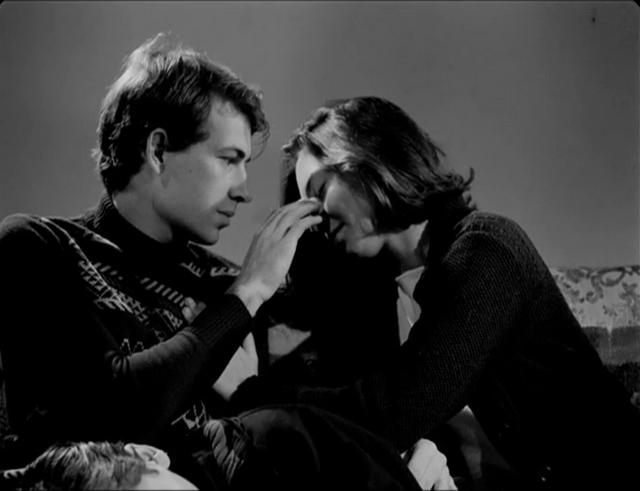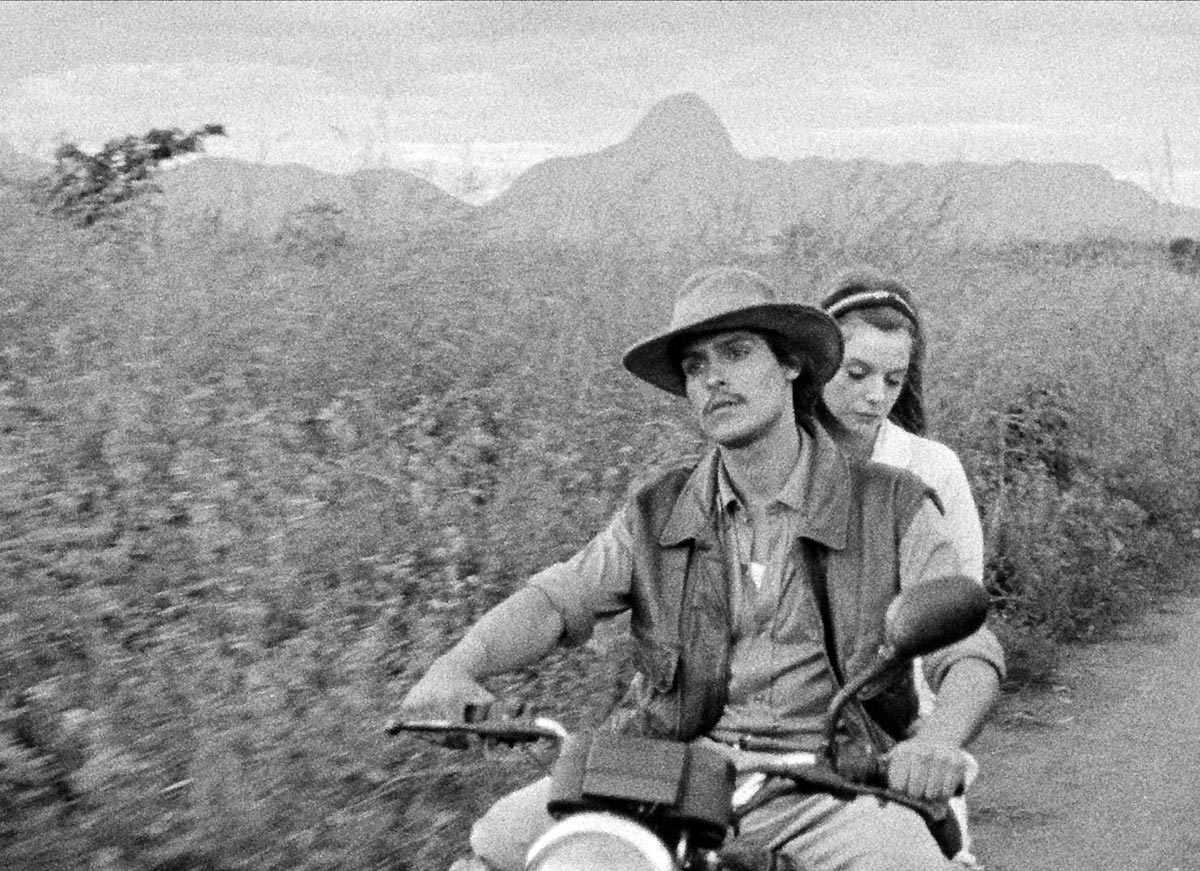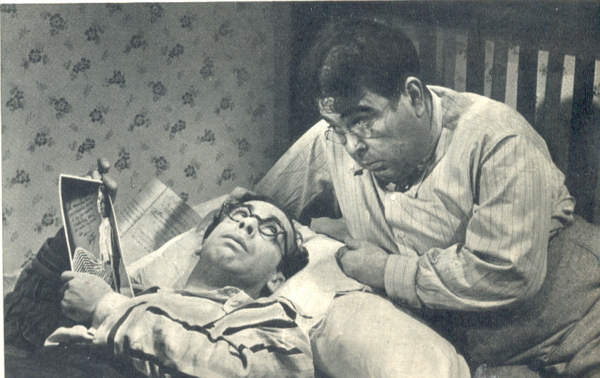10. O Sangue / The Blood (Pedro Costa, 1989)
Costa’s first feature, The Blood, includes elements which would later prove to be his usual focal points: absent parents, displacement, and unresolved pasts. After the death of their abusive and rascal father, two young brothers and a teenage sister try to tackle their way in the world, illustrating how blood ties are strong, yet not always enough.
American Actreess Michelle Carey described the film perfectly: “Filmed in milky black and white, each shot is so carefully composed the film could well be a montage of a thousand photos were it not for the emotive, intelligent dialogue, dreamy orchestral score and excellent use of pop music.”
Thus, simple elements such as quick glances and light sources build a dynamic cinematic world where shots meet and part without concern. The director used rough cuts and diegetic sound, turning it into a fragmented celluloid project in time, space, and narrative. The Blood is a brilliant anomaly of Portuguese cinema from the 1980s, bringing together Costa’s influences and attention to gesture and poise over any storytelling rule.
9. Tabu (Miguel Gomes, 2012)
After he received recognition for his previously mentioned film, Our Beloved Month of August, Miguel Gomes brought us Tabu, cinephile’s homage to F.W. Murnau’s 1931 docufiction of the same title.
The possibility of love and the lack thereof, between Portugal and Mozambique, is black and white film, half of it shot on 35mm, the other half on 16mm film. There are two different stories in different two contexts: one set in a colonial society in Africa and the other in post-colonial society in Portugal. At first, viewers find three women – an old eccentric lady called Aurora, her underestimated Cape Verdean maid, and her worrying neighbor. After a strange request from the old lady, the other two leave in search for a man, who they find is not so sane either, but has a story to tell from fifty years before that involves Aurora.
A memorable film whose technical aspects give it the imagery, music, and ambience and is only perfected by the director’s outstanding input.
8. Recordações da Casa Amarela / Recollections of the Yellow House (João César Monteiro, 1989)
João César Monteiro (1939-2003) remains one of the most eccentric of all Portuguese filmmakers. He is characterized best by his contribution to postwar European cinema, but is only now becoming more recognized for it. There’s much to be said about this man, but there’s a trilogy that reveals it better.
This film is the first installment of said trilogy – all but one appearing on this list – about a man called João de Deus (John of God), a depraved, philosophical, outrageous alter-ego of the director. The trilogy explores autobiographical aspects of Monteiro’s life in a sarcastic, ill-tempered manner—in a world that is entirely his own. Raised in an extremely Catholic family, but an atheist as an adult, the director pays special tribute to the Portuguese-born patron saint of prostitutes, João de Deus.
There’s an inherent visual style that works through sunlight and natural shadows , which adds authenticity to the film. The film, which includes consequent disasters with the police, is enveloped around a story about being poor, getting rich, and losing everything again. One of cinema’s greatest contemporary filmmakers, all whose films are important contributions to Portuguese cinema.
7. O Leão da Estrela / The Lion of the Star (Arthur Duarte, 1947)
Firstly, there’s a need to explain the title of this film. In Portugal, supporters of Sporting Clube de Portugal, a football club, are known as “leões” (“lions”), due to its mascot; and “Estrela” (“star”) is the name of a parish in Lisbon, where the main character lives.
The film portrays the story of a football fanatic from said parish who travels to the North of Portugal with his wife and daughters to see his favorite team play. They stay with a family they had met beforeand who are pecunious. During their stay, the main character does his best to convince the hosts that his family’s equally wealthy, which obviously does not turn out well.
Having achieved considerable success, The Lion of the Star is one of most remembered national films of its time. Besides being a terrific comedy, the film features a star-studded cast and is an important testimony of the representation of Portuguese society in the national film industry of the time.
6. José & Pilar (Miguel Gonçalves Mendes, 2010)
José Saramago (1922 – 2010) was a Portuguese writer and recipient of the 1998 Nobel Prize in Literature. He was highly criticized by the Catholic Church and the EU for being an advocate of libertarian communism. In 1992, after his novel had been politically censored, he went into exile on the Spanish island of Lanzarote, where he resided with his wife until his death.
José & Pilar is a documentary that follows the writing process of his 2008 novel, The Elephant’s Journey. The irony of the film is that it is, itself, a portrayal of the writer’s own journey, his travels, press conferences, and daily life. The audience witnesses this brilliant man, adored and hated by many, as he struggles with his own mortality. Everything in Mendes’ film looks (and feels) as honest, intimate, and witty as anything Saramago has written. The film adequately reflects both sides of the couple, their enormous desire to live, and their strong belief—which is easily transferred onto the audience as well—that they were made for each other.
5. A Comédia de Deus / God’s Comedy (João César Monteiro, 1995)
The second installment of the trilogy of Deus (God) brings back the skinny, old, perverted and philosophical man we got to met in the first film. Once more, the director proves he has created a unique, timeless character. Not once does he lose his poise; even when defied by stronger men, or after uttering the most outrageous, depraved words to much younger women.
What would seem unthinkable becomes humorous in how he ridicules everything and everyone with an aristocratic, well-spoken, playful tone. God’s Comedy demonstrates to viewers the power of satire, which Monteiro does so well, along with his passion for challenging ethics, Christian morals, politics, good manners, society, etc.
“Recollections” first brought us this style, but Comedy is the film in which the audience views the character as he doubtlessly is. It gives us wiser words, puns and retorts, greater shots without a need for dialogue. Undoubtedly, Monteiro’s devotion to the French Nouvelle Vague and to cinéma d’auteur, in which he has undeniably outdone himself.
4. O Pátio das Cantigas / The Courtyard of the Ballads (Francisco Ribeiro, 1942)
In the “Golden Age” of Portuguese Cinema exist several classics—some present on this list, some not—from the 1930s/1940s.
The Courtyard of the Ballads takes place, as usual, in a Lisbon neighborhood, during the annual celebrations of the Popular Saints. Featuring famous actors Vasco Santana, António Silva, and Fransisco Ribeirinho (the director) himself, the film illustrates a vast number of misunderstandings and double entendres. By using a few very stereotyped characters with their own set of issues and desires, the three actors are able to perfectly capture the entire Lisbon atmosphere during such communal anniversary celebrations.The film is wonderfully tied together with subtle, yet effective, direction.
Memorable lines and gags have stuck since then, like the scene where Vasco Santana’s character goes home drunk and tries to persuade a street lamp to light his cigar. This film is certainly one of the most celebrated and beloved popular comedies of Portuguese Cinema.
3. O Pai Tirano / The Tyrannical Father (António Lopes Ribeiro, 1941)
The Tyrannical Father, another “Golden Age” film is one of the best examples of the energy and vitality of classical Portuguese comedies, and this particular film is often considered the most well composed of all of them. In the first national comedy of the 40s, after some unsucessful previous projects, the director proves his evolution in the business. This film’s main attractions are the actors Vasco Santana and Francisco Ribeiro (brother of the director and the perk of the story); it is more complex and brilliant than usual, with great influence from similar genre comedies from the USA and even Europe during the time period.
A story within a story (or an embedded fabula)—in which cinema and theater mingle with the characterization of Portuguese lives and the human condition—also exists. The film features some of the best performances in the careers of these actors, with showdown between social classes and troubles, and famous innuendos that lead up to the finest and smartest gags.
2. A Canção de Lisboa / A Song of Lisbon (José Cottinelli Telmo, 1933)
“The first Portuguese film made by Portuguese people,” as it was announced on the original promotional poster, was directed by an architect (Cottinelli Telmo), who made this his only feature film and thereby founded the “Portuguese comedy.” He combined a series of elements polished by the “New State” dictatorship, such as: fado (a Portuguese music genre), popular festivities, alcoholism, kooks from typical neighborhoods, the rich and old, the fixed up poor people, and social progression.
Without ever having filmed or entered a studio before, Cottinelli conceived and made a film which shows an extraordinary, unusual cinematographic mastery. Without argument, Cottinelli made one cheerful, lively film that gradually shows the viewers magnificent pieces of cinema, technique, and bold results. The environment channels directly into the soul of the popular, accompanied by extremely happy (and timeless) music, making it perhaps the most obvious must-see of all Portuguese films.
1. Aniki-Bóbó (Manoel de Oliveira, 1942)
“Aniki-Bóbó,” a rhyme from a children’s game such as “Eeny, meeny, miny, moe,” is also Manoel de Oliveira’s feature-length debut of the same name—a tale of children in Porto, his hometown
Aniki-Bóbó is the grand Portuguese film of the 40s; the film that always comes to mind when one is thinking of the cinematographic productions of the decade. Unloved when it opened in 1942, the film was later re-evaluated after the success of two other films directed by de Oliveira. Aniki-Bóbó then received its first references in the most important cinema magazine of the time, Cahiers du Cinéma, including a reference by André Bazin in 1957.
The poetical realism present in the film, which is created through the authentic Portuguese culture and traditions, underlined its connection and suspected anticipation to Italian cinema; yet the film also gave a much needed raw focus on child labor. Children are filmed as adults, with issues, passions, needs and attitudes in order to make the audience understand their isolation – a social metaphor – and their lives in the middle of World War II. The photography and director’s work are most noticeable in the long takes typical in Manoel de Oliveira’s following films, but the narrative is fluent and engaging right until the end.
Author Bio: Alex Gandra is a Portuguese writer and filmmaker.She graduated this year in New Communication Technologies from the University of Aveiro and is currently in a master’s degree in Digital Audiovisual. She spends too much time in cafés writing scripts and other kinds of texts you can find at medium.com/@gandra_le. She’s also writing a book she hopes to finish some day.









